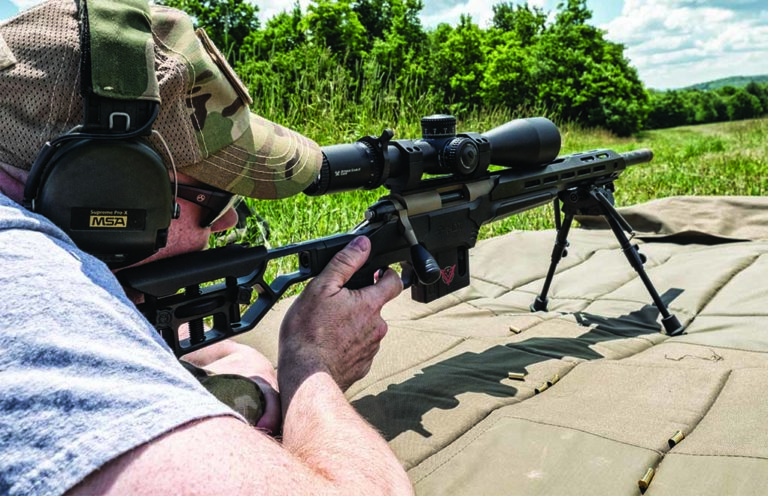
ELR Rimfire requires the same skill set as centerfire 2-mile shooting … but at yardages most gun nuts have close to home.
Everyone needs a buddy like Chad.
A.J. Stewart, a 34-year-old industrial technician from Mobile, Alabama, had dropped three .22 LR shots onto a steel target at 825 yards—and into a group about the size of a dip can. Now, with a ridiculous 120 mils of elevation doped into his rig, he sent it to 1,000.
But, it wasn’t going well.
The splashes looked to land in front of the 30×30-inch steel square, so Stewart spun up more elevation.

“With .22 LR, at that distance, to get it to travel another 5 yards, you need a whole mil of elevation,” Stewart told me. “That’s how steep the bullet is coming down. One meter of elevation for 5 meters of distance.”
He went to 122, 123, 124, 125. Still, no hits.
“Aw, hell!” said his friend and shooting partner, Chad Long, “I’ll go down there.”
Extreme long-range shooting (or ELR)—as with King of 2 Mile events, at which teams of centerfire shooters send .50 BMGs and their derivatives beyond 3,500 yards—makes regular use of forward observers. Chad Long knew this. He took his truck to 1,000 yards and got safe behind some heavy construction debris.
Stewart shot, and Long radioed back. “You’re 35 feet or so behind the target.” Through the spotting scope, Stewart and his team saw the splashes under the steel target, not in front of it, as they first thought.
Stewart walked down the elevation. When he got to 113 mils, he shot and waited. A full 5.5 seconds later, the 40-grain, lead round-nose connected. A few seconds after that, prone on his shooting mat, Stewart heard a faint, but distinct, ding. “That,” he told me, “was the best sound in the world!”
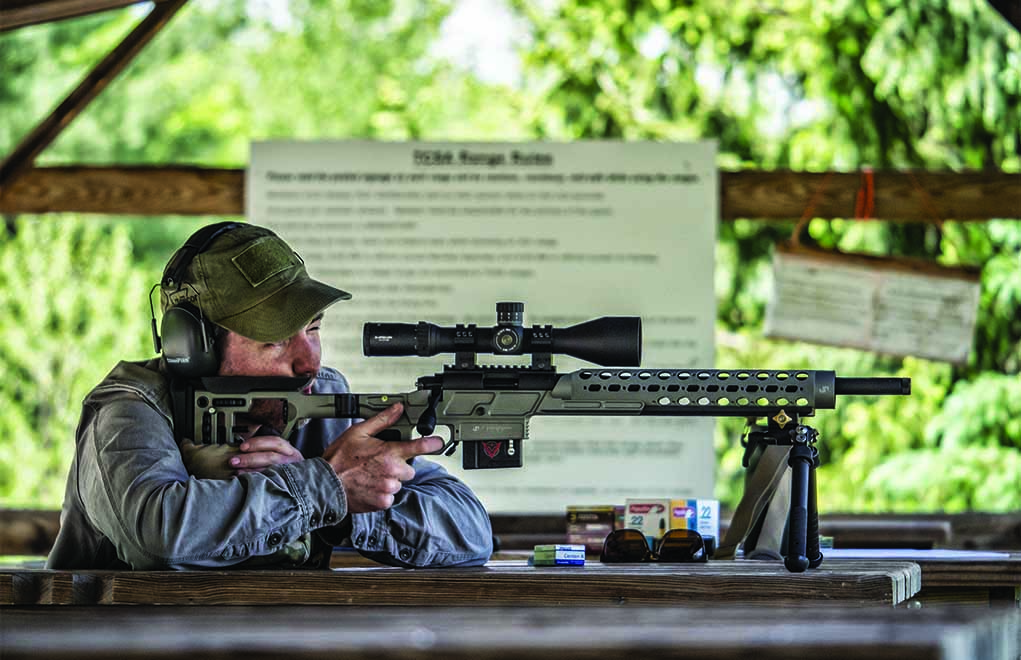
Stewart shot again.
“Hit,” Long radioed back. “Hit. Hit.” Four in a row. They’d solved the 1,000-yard .22 LR puzzle.
Stewart wasn’t the first guy to repeatedly connect at 1,000 yards with a .22 LR, but on that day, he joined a very small club of ELR rimfire shooters.
Yet, as rifle builders, ammo makers and optics engineers continue to push the bounds of distance, that club’s only getting bigger.
Do You Vudoo?
I’ve never seen someone squirrel hunt at 1,000 yards, you might be thinking. Well, you could be missing the point of ELR. Like its centerfire brother, ELR rimfire shooting is the “Space X” of long-range precision—a program and a practice operating on the outer edge of “possible.” Advances learned in ELR inevitably trickle backward—as we’ve seen in the last 10 years with the rush of modern high-BC bullets, bipod systems, and range-finding and wind-reading technology. Many of those ideas were first “proofed” by long-range fanatics at unreasonable distances.
If any one company is responsible for this kind of proof-of-concept work in the ELR rimfire space, it’s Vudoo Gunworks of St. George, Utah. Mike Bush, the director of engineering at Savage Arms, had been converting Remington 40x actions to repeaters for a small crew of diehard marksmen on an Internet forum. Bush couldn’t keep up with the demand. As a result, along with industry veterans Jay Phillips, and Paul and Jill Parrott, he started Vudoo (the name comes from an old saying of the Parrotts: that the difference between an MOA rifle and a ½ MOA barn-burner was always “a little bit of magic, a little bit of voodoo”).
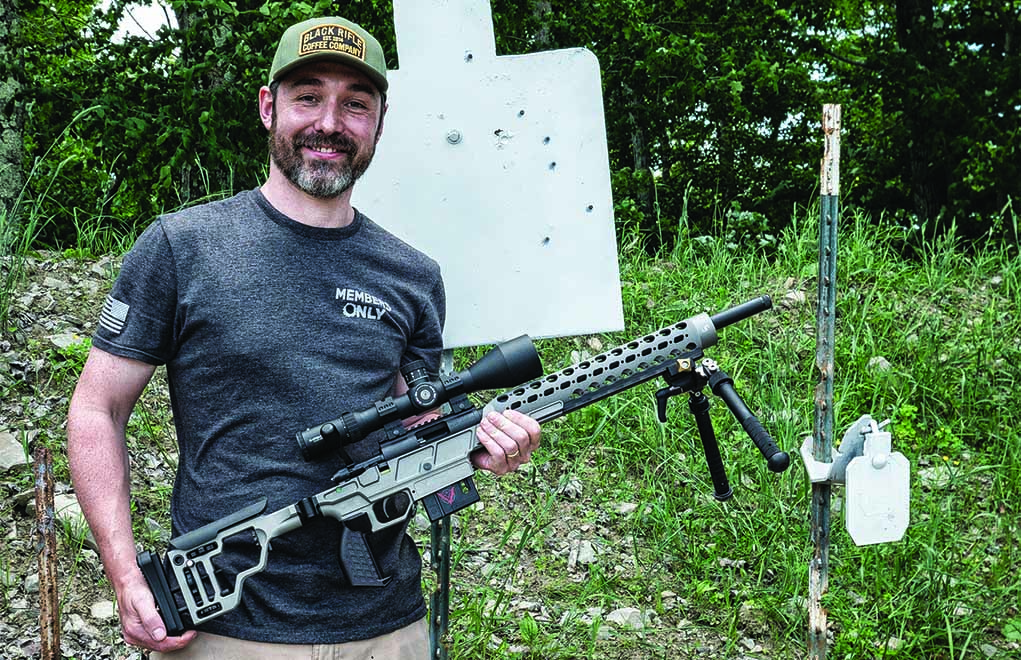
With the wars in Iraq and Afghanistan—and movies about them, such as American Sniper—interest in precision shooting over the last 15 years surged here, on the home front, as well as around the world. Recreational sharpshooters soon realized they could train with a low-recoil, low-cost .22 LR that still required all the sniper math and wind-reading needed to hit a long way off, but at a shorter distance. Rather than find a place to shoot at distances of 1,000, 1,500 or 2,000 yards, they could do it all at 400-, 500- and 600-yard ranges.
As more and more shooters tried out .22 LRs at longer and longer ranges, they took their problems and solutions online to forums such Snipers Hide, where the small-bore rifle-of-choice morphed from Bush’s 40x conversions to the Vudoo Gunworks V-22 action—the first custom rimfire action to use a Remington 700 footprint. With a Vudoo, shooters could build an exact replica of its ELR or PRS rifle—same chassis, trigger, bases, rings and optic with an AICS-patterned magazine—but in .22 LR.
The success of Vudoo and the expanding ELR rimfire market has inspired a boom in full-sized Remington 700-footprint .22 rifles. Bergara released the B-14-R late last year. The RimX action from Zermatt Arms debuted at SHOT Show in January, as did the Ultimatum Precision Deuce, as well as a .22 LR conversion kit from Curtis Customs. Elite barrel makers such as Proof Research and Lilja Precision rolled out uber-accurate tubes for swap-barrel rimfire actions such as the CZ 455/457 and Ruger Precision.
Add all of this together, and there’s never been so many options in insanely accurate precision rimfire rifles—rifles capable of pushing a little, 40-grain hunk of lead farther, and with repeatable accuracy—than most people thought possible even five and 10 years ago.
Get On Target With Long-Range Shooting:
- Mils vs. MOA: Which Is The Best Long-Range Language?
- Buying the Perfect Precision Scope
- Shooting Positions: Variety Is The Spice Of Life
- Riflescope Tracking: Why It’s Crucial To Test It
- Long-Range Shooting: Becoming Your Own Spotter
All About Ammo
When shooting a .22 LR between 300 and 1,000 yards, the rifle is just one piece of the system. Equally important is high-quality match ammunition that gets along with the rifle’s chamber and barrel—ammunition made nine times out of 10 by Eley or Lapua.
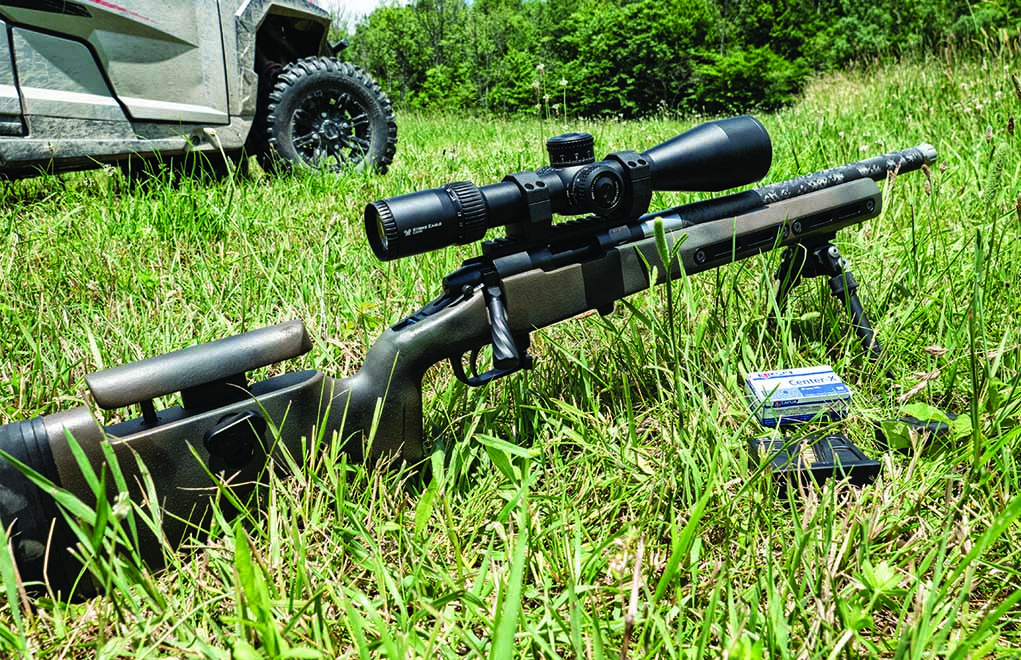
With match ammunition that runs just below the speed of sound (Lapua is advertised at 1,073 fps), the 40-grain bullet doesn’t pass through the transonic barrier, which adds a level of instability at longer ranges. This is why high-velocity ammo often doesn’t maintain a good level of accuracy at extreme distances. Knowing which one of the few high-quality match loads a rifle likes is an exercise in trial and error that requires a chronograph.
Vudoo has smartly cut out much of the guesswork, because all its chambers are cut to Lapua dimensions (my RimX with a 16-inch Proof barrel seems to be “ammo-agnostic,” shooting Lapua and Eley equally well. My Bergara is leaning toward Lapua).
At the chronograph, muzzle velocity is important, because you’ll need that figure for long-range ballistic-solving. However, extreme spread or standard deviation—the spread in feet per second (fps) between the fastest and slowest muzzle velocity in a string—is absolutely critical.
Standard deviation is “the number-one limitation for extreme long-range shooting with rimfire,” Geoff Esterline, director of marketing for Lapua, Berger and Vihtavuori within the United States, told me. “We often have production lots of Lapua with single-digit SDs. The challenge becomes identifying a lot that’ll reliably offer consistent ignition through your firearm platform.”
The second major ballistic factor is wind. But, for the sake of this example, we’ll assume an ELR shooter has a good handling on wind-reading.
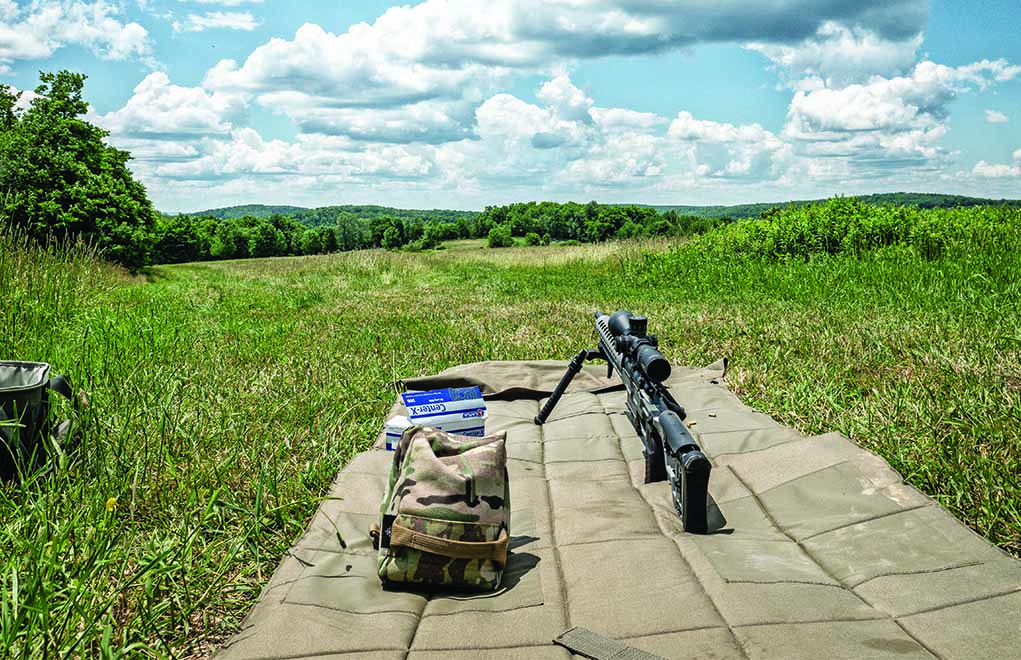
To illustrate the importance of low SDs and mild wind on ELR rimfire shooting, let’s use the Weapon Employment Zone Analysis calculator (AppliedBallisticsLLC.com). It calculates a “hit probability” based on various shooting conditions.
Using Lapua bullet dimensions and their advertised BC of .172, along with no wind and an SD of 10 fps in a ½ MOA rifle, the hit probability at 500 yards is 74.4 percent. With a 2.5 mph wind and an SD of 15, that drops way off to 12.2 percent. At 4 mph and a 20 fps SD, it’s 1.6 percent. Most non-match, mid-tier subsonic .22 LR ammo has an SD between 20 and 80 fps. (If that doesn’t tell you why premium ammo is important, I recommend you take up Steel Challenge.)
Lapua says its Center-X, Midas+ and X-Act ammunition will produce a single-digit SD. That might be true on average, but every rifle ignition system and ammo combination is different.
A.J. Stewart sees single-digit SDs in his Vudoo with X-Act and a range between 10 and 20 fps with Midas+ and into the 30s with Center-X (this is the reason he makes 800-plus-yard attempts with X-Act only). I’ve seen single-digit strings with Center-X in my Vudoo and RimX rifles, with the occasional oddball shot in the 20s or 30s.
At 50 yards, an SD in the 20s can still make a “one-ragged-hole”-sized group: five shots touching in a tight cloverleaf. So, only group-shooting a .22 LR at 50 or 100 yards to determine the best ammo can be deceiving if the goal is to eventually shoot at much longer ranges—at which SD will have a significant effect.
Chronographing lots of ammunition—that is, lots of lots of ammunition—is the best way to determine the best ammo-to-rifle fit. If that sounds daunting, you can send your rifle to Lapua Performance to have the testing done for you for $50. Ten-shot strings are recorded at 50 and 100 meters—right down to the best-performing lot number—and the data is e-mailed directly to you.

In Lapua’s case, Center-X, Midas+ and X-Act all comprise the same case, primer, powder and bullet. What box those rounds end up packaged in is determined by how that lot tests off the production line: The most consistent, lowest-SD lots become X-Act. But, thanks to the weird science of rimfire, some rifles might shoot Center-X better than X-Act. Sending a rifle to get tested will identify this and could save you a bundle of time and money down the road.
You Can’t Hit What You Can’t Dope
Rifle and ammunition figured out, how do you get enough mils or MOA into your rig to connect at 300- to 1,000-plus yards? As with long-range centerfire shooting, the optics platform starts with a canted Picatinny rail.
Most 30mm scopes have around 18 mils of total elevation adjustment, whereas 34mm tubes hover around 30 mils. But, if the scope is zeroed at the center of its elevation adjustment, you’ll only have half that total figure in come-ups—9 and 15 mils, respectively. To bottom out the scope so the zero is at the low range of adjustment, it takes a canted rail—typically, between a 30 and 60 MOA rail with 30mm and 34mm optics.
The distance at which you zero the rifle also matters. If you plan to shoot NRL22 events with your ELR setup, a 50-yard zero is smart, because it’ll allow you to hold dead-nuts from 10 yards to 55 or 60 yards and spin up for anything farther (with a 34mm Athlon Ares ETR, I’ve been able to get a 50-yard zero with 35 MOA of cant in my rail and rings). However, if it’s a dedicated ELR rifle, a 100-yard zero makes more sense and lets you get more distance from your setup.
With a 34mm scope (such as the new and very excellent Strike Eagle from Vortex), 60 MOA of cant is the way to go for a dedicated ELR build. Nightforce makes one, as does Sphur, with a one-piece base-and-rings system. Burris Extreme Tactical Rings, which come with plastic MOA shims, are another way to add even more cant. With 10 mils in the reticle, plus some additional holdover, these platforms will make optics packages capable of the roughly 42 mils required to connect with a .22 LR at 600 yards. With lots of cant, a good 34mm scope and using all of the reticle, 600 yards is about the limit to which most .22 LR rigs can be pushed without specialized equipment.
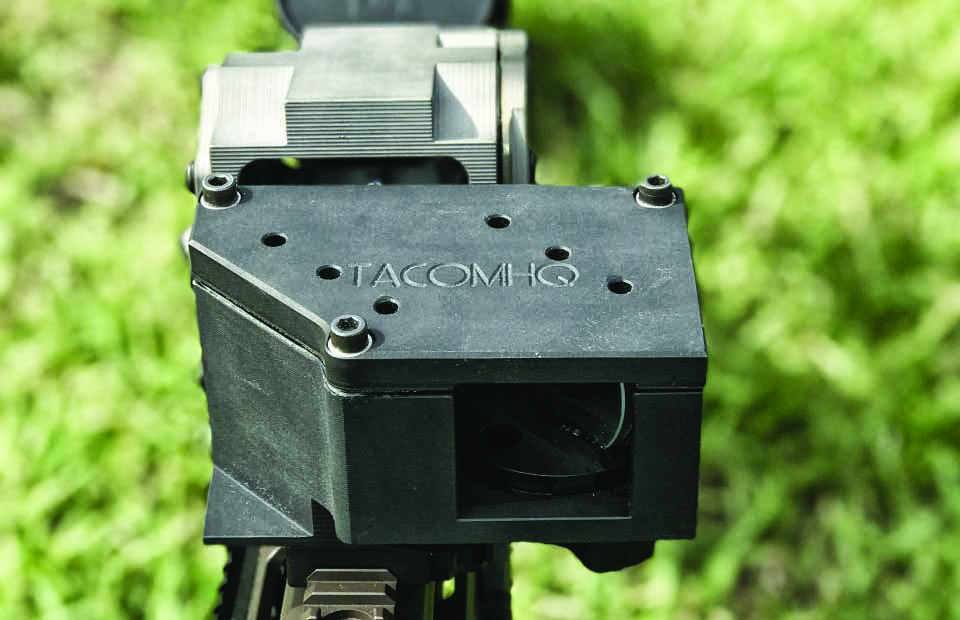
To get enough dope to connect after 600 yards requires a unique device—the Charlie TARAC from tacomHQ. A little black box that connects to the scope’s objective lens or forward of the scope via a Pic rail, the Charlie optically adds elevation up to an additional 250 mils. This device works very much like a periscope—using mirrors to shift the point of aim higher, reflecting light, so the target image stays bright and optically centered in the scope. It’s what Stewart used to make his 1,000-yard .22 LR shot and what the likes of Paul Phillips and company use at centerfire King of 2 Mile events to send .416 Barret rounds well past 3,500 yards.
A Charlie TARAC and 1,000-yard hits with a .22 LR comprise a rarified pursuit of extreme ELR enthusiasts, but what they’re learning is actively informing rifle, ammo and optic designs. For the rest of us mortals, a difficult, but very possible, ELR .22 LR shot is something closer to 500 yards.
All Together Now
To test this all out, I took two rifles to buddy Dave Sweet’s 500-yard range at Spray & Pray Coatings in western New York. Sweet shoots a Vudoo and had just mounted a new Vortex Strike Eagle. I brought a Vudoo with an 18-inch ACE barrel in a JP APAC chassis, 20 MOA rail, Athlon Conus BTR scope, a RimX with a 16-inch PROOF barrel, 30 MOA rail and Strike Eagle scope in a Grayboe Ridgeback. Both rifles had Timney HIT triggers set around 1 pound. We had previous dope on all the rifles to 200 yards; and, very quickly—within fewer than five shots—all the guns rang steel at 326 yards shooting Lapua Center-X.
We jumped back to 500 yards as the wind picked up. The contour of our hilltop range made for a 90-degree wind at 5 mph, gusting to about 10 or 12. However, at the target pit through a hedgerow in the field, the wind switched to head-on, with gusts spinning around between 180 and 270 degrees. After 20 rounds of grossly overcorrecting for wind, I held 1 mil, and Sweet spotted the impact in the bank just over the top of the plate. My elevation was off a good bit, too.
With centerfire rifles, it’s possible to true your ballistic software by tweaking the muzzle velocity or the BC. With rimfire, this often doesn’t work.

Stewart recommended a BC of .132 for all Lapua ammunition, which I used. It put me at 29 mils for the 503 yards we were shooting.
Kestrel recommends using the DropCal function to calculate ELR rimfire shots; that is, input real-world dope at various distances and let the Applied Ballistics software compute farther-out targets based on those known variables. I did this with my 100-, 200- and 326-yard data and arrived at the “magic number” for this Vudoo/Center-X combination at 503 yards: 27 mils. I spun 20 mils up and held 7 with the reticle, with 1 mil for wind.
Ding!
We heard the shot connect, loud and clear. Then, another. Ding! Ding! Ding! We started at 9:30 in the morning. By lunchtime, all the rifles were printing groups on steel, even in the crazy wind. Sweet’s 10-year-old son Mikey was soon making reliable hits at 500 too.
I texted Stewart, who’s provided me with lots of ideas and advice along the way.
“Nice!” he wrote back. “So, when you gonna try at 1,000?”
Editor's Note: This article originally appeared in the 2020 Long-Range Shooting issue of Gun Digest the Magazine.

Next Step: Get your FREE Printable Target Pack
Enhance your shooting precision with our 62 MOA Targets, perfect for rifles and handguns. Crafted in collaboration with Storm Tactical for accuracy and versatility.
Subscribe to the Gun Digest email newsletter and get your downloadable target pack sent straight to your inbox. Stay updated with the latest firearms info in the industry.

![Best Concealed Carry Guns In 2025 [Field Tested] Wilson Combat EDC X9S 1](https://gundigest.com/wp-content/uploads/Wilson-Combat-EDC-X9S-1-324x160.jpg)


![Best 9mm Carbine: Affordable PCCs [Tested] Ruger Carbine Shooting](https://gundigest.com/wp-content/uploads/Ruger-Carbine-Shooting-100x70.jpg)
![Best AR-15: Top Options Available Today [Field Tested] Harrington and Richardson PSA XM177E2 feature](https://gundigest.com/wp-content/uploads/Harrington-and-Richardson-PSA-XM177E2-feature-100x70.jpg)
